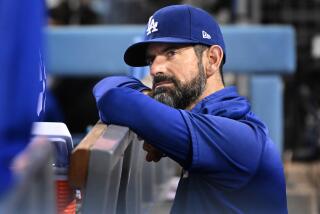Pryor’s Victory May Be His Loss : Boxing: The former champion should say <i> no mas</i> to his comeback attempt and get out of the game before he loses it all.
- Share via
MADISON, Wis. — No mas .
Roberto Duran said it to Sugar Ray Leonard in a moment of weakness a decade ago, but Aaron Pryor should say it now in a moment of strength to himself.
No mas .
No more.
Enough.
The once-fearsome junior welterweight champion of the world returned to the ring Wednesday night after an exile of 17 months but left more than a few in the crowd of 400 wishing it had continued longer than that. Pryor easily dispatched a pug and former sparring partner named Daryl Jones, though it was a dubious conquest at best.
Jones came out of retirement himself after two years with no other purpose, it seemed, than to find a comfortable spot on which to land. And after giving Jones two chances to find that place during the second round, Pryor, carrying too much weight on legs too stiff and trying to measure his punches with a left eye that barely sees, set him down for good at 1:15 of the third round.
The finisher was a short right hand following a four-punch flurry. But more important, it may have started Pryor down a path from which there is no turning back. Because now the man is certain he can still fight.
Jones, depending on whom you believe, brought a record of 17-12 or 26-7 or 13-12 into the ring. But the next tomato can Pryor’s handlers line up--or the one after that--in a bid to lend respectability to Pryor’s comeback won’t be as old (Jones was 37) or as slow or as considerate.
But no one around him for the time being is likely to tell him that, and Pryor, still rushing from adrenaline a half hour after the bout, cannot see that for himself.
“Under pressure, I came back with something. And I know now,” Pryor said, “that I want to fight. I can still deal with it.”
Earlier Wednesday, it seemed, mercifully, that this crucible might never come. The Wisconsin Department of Regulation and Licensing reversed itself and denied Pryor a license to fight, something that the boxing commissions of New York, New Jersey, Nevada and California had done on the first go-round.
In fact, the reason the 34-year-old Pryor picked sleepy Wisconsin to begin the long march back to boxing’s throne room was because officials of the sport’s more glamorous venues looked at his left eye and just said no.
In January, 1989, he had cataracts removed and a detached retina repaired, and in the view of the commissions of the major boxing states, the surgery left him a one-eyed fighter. In the view of Wisconsin, however, which closed up its own boxing commission a decade ago and turned such matters over to the licensing agency, Pryor was simply a man with a handicap looking for work.
And in a state where anti-discrimination measures are interpreted so literally that a blind man recently was granted a license to hunt deer, Aaron Pryor was granted a license to hunt heads. Using his own as a decoy.
About five hours before Pryor’s fight, the licensing agency reversed itself yet again--after his promoter received a court injunction.
In his unbeaten climb to the top of the division, Pryor cashed about $4 million in purses and went through it even faster in a slide that began soon after his retirement from the game in the mid-1980s. The leaches who attached themselves to his fame and fortune were forever making off with his cars and his money and--on one occasion--his gun. And cocaine and marital problems consumed what was left.
And Wednesday night, when he arrived at the arena, Pryor was three months out of drug rehab and probably half-scared to death that this fight was his last chance to prove he still had something.
“The beginning is the most important thing. If there was going to be a breaking point, it was here,” he said. “It would be easy to take drink or do drugs . . . but I got through that.”
Ultimately, he got through Jones as well.
Pryor spent the first round circling the ring, missing wildly with right-hand leads, but thrusting out his chin in a taunting display. In the second round, Pryor twice put Jones down with quick-handed combinations.
“After the knockdown, I asked him to get back up,” Pryor said, “and he got serious. As the fight went on, he got a little more serious and caught me around the eye. . . .
“I got back to my corner and asked, ‘Am I having a problem (seeing), or is he just fast? Didn’t he tag me a couple of times?’ ”
The answers: You are and he did--although not as hard as the next tag is likely to be.
Last week in Milwaukee, when someone asked Pryor to read a clock on a balcony overhang about 40 feet from where he sat, he squinted, gathering up the scars at the corners of his eyes, and finally conceded that he could not.
But he quickly added that doctors have told him that with corrective lenses he could expect to retain 20-50 vision in the left eye. And then, lowering his voice to a conspiratorial whisper, he admitted to serious misgivings about the upcoming fight and said, “I’d get me a job before I’d put my life on the line.”
If Aaron Pryor continues to box, that time may arrive sooner than he is prepared to meet it.
More to Read
Go beyond the scoreboard
Get the latest on L.A.'s teams in the daily Sports Report newsletter.
You may occasionally receive promotional content from the Los Angeles Times.










